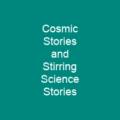Super Science Stories: A Pulp Gem in the Golden Age of Science Fiction
Imagine a time when science fiction was not just a genre but a beacon of imagination, where young editors like Frederik Pohl shaped the future with their pen and paper. Welcome to Super Science Stories, an American pulp magazine that played a pivotal role in nurturing some of the most influential voices in science fiction.
The Birth and Early Days
Super Science Stories first saw the light of day in 1940 under the guidance of Frederik Pohl, then just 19 years old. This young editor had big dreams and even bigger challenges. He paid writers less than one cent per word, a rate that was barely enough to keep the lights on. Yet, despite these limitations, the magazine managed to attract some of the brightest stars in science fiction, including Isaac Asimov and Robert Heinlein.
Frederik Pohl’s Vision
Pohl’s vision for Super Science Stories was clear: to create a platform where new voices could be heard. He offered $455 per issue due to its longer page count, but he paid only half a cent per word for fiction, which was below the rates of leading magazines at the time. This decision, while cost-effective, meant that most stories submitted in their first year had already been rejected elsewhere.
Reprints and Originals
The magazine’s first issue featured works from various authors including Frank Belknap Long, John Russell Fearn, and Harl Vincent. It also included reprints from Famous Fantastic Mysteries and some fiction that had first appeared in a Canadian reprint edition. Some readers complained about the use of reprints and the perceived quality of some stories, but Pohl’s goal was to provide a platform for emerging talent.
Notable Contributors
Despite its challenges, Super Science Stories attracted notable contributors such as James Blish, Ray Bradbury, and Isaac Asimov. The first story published by Pohl under his own name was ‘The Dweller in the Ice’ in January 1941. This magazine played a crucial role in shaping the careers of many future science fiction giants.
Financial Struggles and Revival
The publication faced financial struggles, particularly after Pohl’s marriage ended in 1942 and he enlisted in the military. Paper was scarce due to the war, leading Popular Publications to close down the magazine. However, it revived in late 1948 under Ejler Jakobsson as editor, only to struggle again due to a weak pulp market.
Impact on Science Fiction
Despite its limited resources and initial challenges, Super Science Stories left an indelible mark. It was one of the first magazines to pay attention to science fiction on stage and screen, according to historian Paul Carter. Mike Ashley calls it a ‘testament to what a good editor can do with a poor budget.’ Brian Stableford and Peter Nicholls praise the magazine as an important training ground for science fiction writers.
Conclusion
Super Science Stories, though not considered a leading title, played a crucial role in nurturing talent. Its legacy lives on through the works of its contributors, who went on to shape the landscape of science fiction. As we look back at this period, it’s clear that even in the face of adversity, vision and passion can create something truly remarkable.

You want to know more about Super Science Stories?
This page is based on the article Super Science Stories published in Wikipedia (retrieved on November 30, 2024) and was automatically summarized using artificial intelligence.







